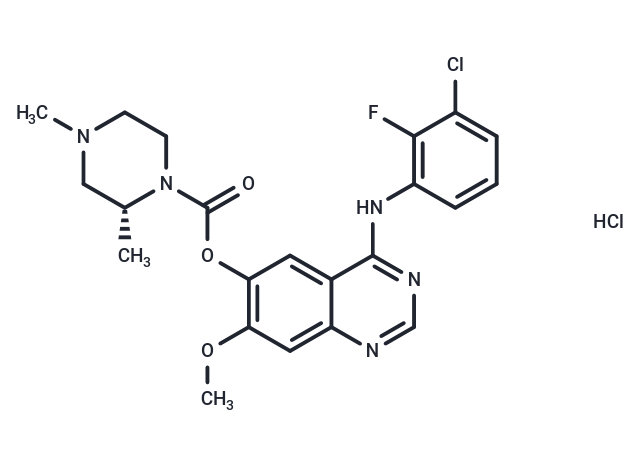Shopping Cart
- Remove All
 Your shopping cart is currently empty
Your shopping cart is currently empty

AZD3759 (hydrochloride) is an effective, orally active and central nervous system-penetrant EGFR inhibitor. At Km ATP concentrations, the IC50s are 0.2/0.3/0.2 nM for EGFR (L858R)/EGFR (wt)/EGFR (exon 19Del).

| Pack Size | Price | Availability | Quantity |
|---|---|---|---|
| 2 mg | $30 | In Stock | |
| 5 mg | $41 | In Stock | |
| 10 mg | $59 | In Stock | |
| 25 mg | $101 | In Stock | |
| 50 mg | $179 | In Stock | |
| 100 mg | $295 | In Stock | |
| 200 mg | $428 | In Stock | |
| 1 mL x 10 mM (in DMSO) | $47 | In Stock |
| Description | AZD3759 (hydrochloride) is an effective, orally active and central nervous system-penetrant EGFR inhibitor. At Km ATP concentrations, the IC50s are 0.2/0.3/0.2 nM for EGFR (L858R)/EGFR (wt)/EGFR (exon 19Del). |
| Targets&IC50 | EGFR (exon 19Del):0.2 nM, EGFR (L858R):0.2nM, EGFR (WT):0.3nM |
| In vitro | At 2 mM of ATP concentrations, the IC50s are 102/7.6/2.4 nM for EGFR (wt)/EGFR (L858R)/EGFR (exon 19Del). AZD3759 also inhibits pEGFR in H838wt (IC50: 64.5 nM), H3255L858R (IC50: 7.2 nM), and PC-9exon 19Del (IC50: 7.4 nM), respectively. In cellular phosphorylation studies, AZD3759 also shows 9-fold inhibition selectivity in EGFR-activating mutant cell lines over EGFR wild-type cell lines (H838 cell line)[1]. |
| In vivo | In rats, absorption of AZD3759 (2 mg/kg, p.o.) is rapid with blood Cmax of 0.58 μM achieved at 1.0 h. And then blood concentrations of AZD3759 decline monoexponentially with a mean elimination half-life of 4.3 h, which is close to the parameter obtained from intravenous dosing of 4.1 h. The bioavailability following an oral dose in rats is 91%. Following the intravenous in dogs, the blood clearance of AZD3759 is 14 mL/min/kg, and the volume of distribution is 6.4 L/kg. Its elimination half-life is 6.2 h. Absorption of AZD3759 is rapid with blood Cmax (698 nM) occurring between 0.5 and 1.5 h. The oral bioavailability of AZD3759 is excellent at 90%. AZD3759 demonstrated significant dose-dependent antitumor efficacy (78% tumor growth inhibition at 7.5 mg/kg/day and tumor regression at 15 mg/kg/day, respectively, 4 weeks after treatment) with <20% body weight loss. AZD3759 (7.5/15 mg/kg) can markedly decrease tumor area. In addition, modulation of pEGFR is detected by a single dose of AZD3759 at 15 mg/kg 1h after dosing[1]. |
| Kinase Assay | AZD3759 is tested at a single 1 μM concentration across each of 124 kinases from Millipore kinase panel at an ATP concentration that is within 15 μM of their corresponding apparent Km values. In brief, recombinant kinases are incubated within an appropriate buffer containing peptide substrate and radiolabelled γ-33P-ATP together with presence or absence of required inhibitor concentration. The reaction is initiated by adding ATP/Mg2+ mix. After incubation for 40 minutes at room temperature, the reaction is stopped by adding 3% phosphoric acid solution. A portion of reaction mix is spotted onto P30 filter mat to trap peptide and washed three times for 5 minutes with phosphoric acid to remove non-specific γ-33P-ATP. The phosphorylated substrate is then measured by scintillation counting, which determined the level of kinase activity inhibition compared to control reactions[1]. |
| Cell Research | AZD3759 is prepared in DMSO and stored,and then diluted with the appropriate medium before use[1].Cell proliferation assay is determined by MTS methods.Briefly,cells are seeded in 96-well plates (at a density to allow for logarithmic growth during the 72-hour assay) and incubated overnight at 37°C and 5% CO2.Cells are then exposed to concentrations of compounds (e.g.,AZD3759) ranging from 30 mM to 0.3 μM for 72 hours.For the MTS endpoint,cell proliferation is measured by the CellTiter AQueous Non-Radioactive Cell Proliferation Assay reagent.Absorbance is measured with a Tecan Ultra instrument.Predose measurements are made,and concentration needed to reduce the growth of treated cells to half that of untreated cells (GI50) values are determined using absorbance readings[1]. |
| Animal Research | AZD3759 is prepared in 1% methylcellulose (Rat)[1].Male Han Wistar rats are orally dosed with the AZD3759 at 2 mg/kg in 1% methylcellulose. At 0.25, 0.5, 1, 2, 4 and 7 hour post-dose, cerebral spinal fluid (CSF) is collected from cisterna magna, and blood samples (>60 μL/time point/each site) are collected via cardiac puncture, into separate EDTA coagulated tubes, and then immediately diluted with 3-fold volume of water. Brain tissue is harvested and homogenized in 3x volume of 100 mM phosphate buffered saline (pH7.4). All samples are stored at -70°C prior to LC/MS/MS analysis. |
| Molecular Weight | 496.36 |
| Formula | C22H24Cl2FN5O3 |
| Cas No. | 1626387-81-2 |
| Smiles | C[C@@H]1CN(CCN1C(=O)OC2=C(C=C3C(=C2)C(=NC=N3)NC4=C(C(=CC=C4)Cl)F)OC)C.Cl |
| Relative Density. | no data available |
| Storage | Powder: -20°C for 3 years | In solvent: -80°C for 1 year | Shipping with blue ice. | |||||||||||||||||||||||||||||||||||
| Solubility Information | DMSO: 50 mg/mL (100.73 mM), Sonication is recommended. | |||||||||||||||||||||||||||||||||||
Solution Preparation Table | ||||||||||||||||||||||||||||||||||||
DMSO
| ||||||||||||||||||||||||||||||||||||

Copyright © 2015-2025 TargetMol Chemicals Inc. All Rights Reserved.